Here, in the latest installment of my Look Back in Bedlam at the year’s more obscure and underappreciated films, we arrive at 1990. That year, as you may recall, was when the so-called “blockbuster mentality” took hold in Hollywood, resulting in overpriced noise-makers like DIE HARD II, DICK TRACY, DAYS OF THUNDER, TOTAL RECALL and THE GODFATHER PART III. This led to the infamous “Katzenberg memo” in which Disney’s then Chairman Jeffrey Katzenberg decried the bloat of blockbuster moviemaking and proposed a new, more frugal path forward. Now, 29 years later, when blockbuster fever has fully engulfed and devoured Hollywood, we can see how well that plan worked out!
I’ve said it before and I’ll say it again: the really interesting cinema is found in the margins. For proof check out the following countdown of thirty lesser known but eminently worthy films…
30. THE HAIRDRESSER’S HUSBAND (LE MARI DE LA COIFFEUSE)
I’ve always liked this thoroughly odd French romance, even though there’s not much to it. Inspired by its director Patrice Leconte’s lifelong passion for lady hairdressers, it concerns a middle-aged man (Jean Rochefort) who like Leconte has grown up with an overwhelming desire to run off with a coiffeuse. He gets his wish upon meeting a seductive salon owner (Anna Galiena) to whom he impulsively proposes—and she, unlikely enough, accepts. This suggests the proceedings might be an extended fantasy or hallucination, although in interviews Leconte has nixed that idea. The film nonetheless has a distinctly hallucinatory vibe, and the authentically dreamy Galiena appears to have sprung full-blown from any number of male fantasies. The latter scenes, in which darkness and uncertainty gradually creep in to taint this romance, are particularly strong, and close things out on an appropriately apprehensive note in which fantasy collides rather harshly with brutal reality.
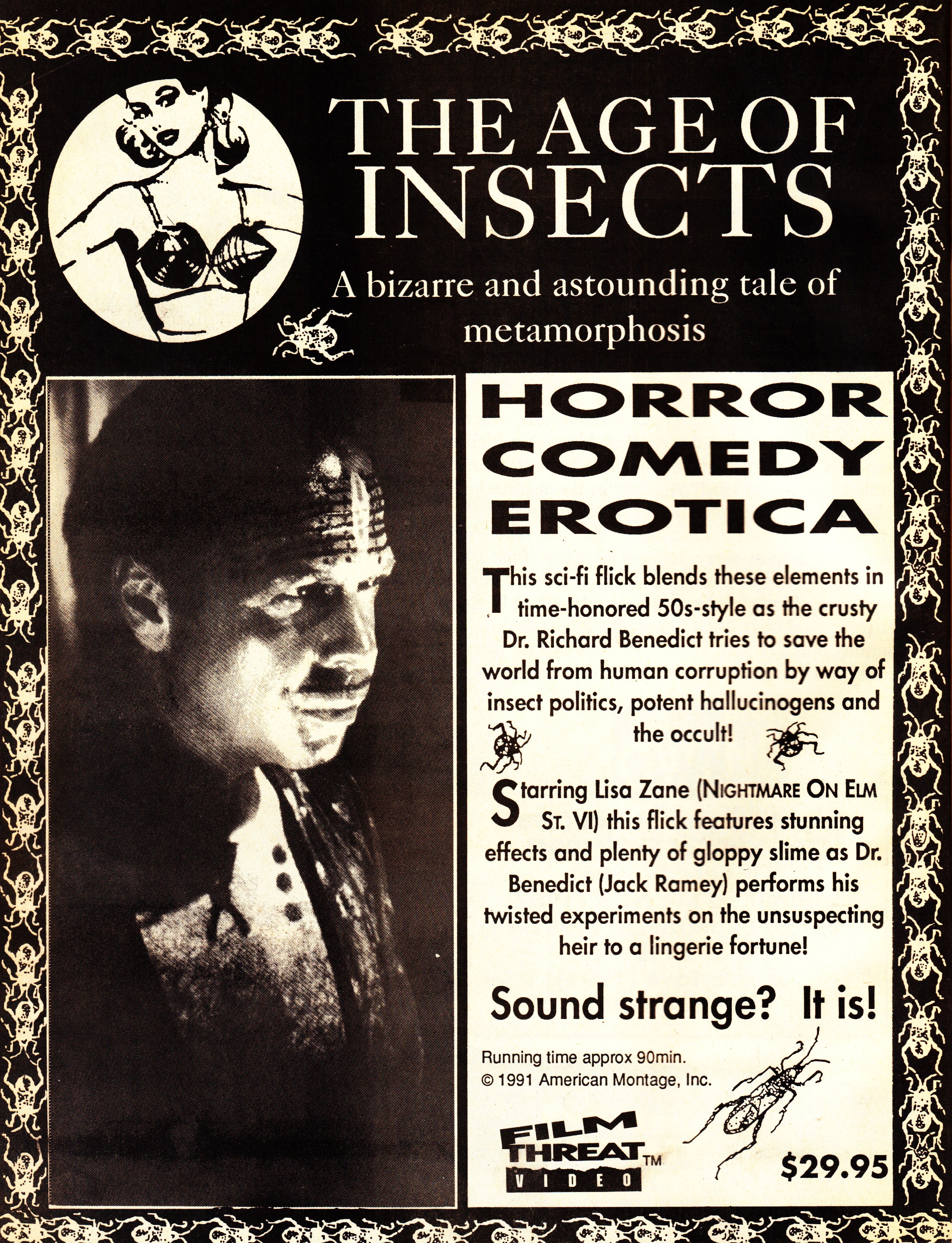 29. THE AGE OF INSECTS
29. THE AGE OF INSECTS
A most interesting product of the nineties filmmaking underground that mixes B-movie silliness with then state of the art video effects. It involves a deranged entomologist luring a delinquent teenager into his fold for use in some kind of experimental ritual. This being a no-budget film, there’s much you’ll need to forgive, including amateurish performances, cut-rate sound mixing and ultra-grainy 8mm film stock. But if you can get past those things you’ll find an authentically visionary piece of filmmaking that incorporates still photography, documentary snippets and extensive pre-CGI video effects into its narrative, and mixes “reality” and hallucination in extremely audacious fashion.
28. YOUNG GUNS II
Not a joke: after UNFORGIVEN this, I feel, was the most striking western of the nineties. A sequel to the middling YOUNG GUNS (1988), it has in its favor the late New Zealand director Geoff Murphy, whose Hollywood output was generally disappointing (with bummers like FREEJACK and UNDER SIEGE 2). This time around, however, he was quite inspired, turning in a vibrant and colorful piece of work with much of the same energy that powered Murphy’s masterpiece UTU (1983). A retelling of the saga that was previously dramatized by Sam Peckinpah in PAT GARRETT AND BILLY THE KID, YOUNG GUNS 2 features Emilio Estevez in the William Bonney (a.k.a. BtK) role and William Peterson as Garrett, residing in a sumptuously visualized western setting along with many of the brat packers who supported Estevez in the first YOUNG GUNS (Lou Diamond Phillips, Kiefer Sutherland, Christian Slater), actress Jenny Wright (who’s never looked sexier onscreen) and a young Viggo Mortensen. What keeps the film from greatness is the merely-serviceable script, which has none of the complexity of Peckinpah’s film, and the music video pacing, which is too hasty for its own good.
27. GOLDEN BRAID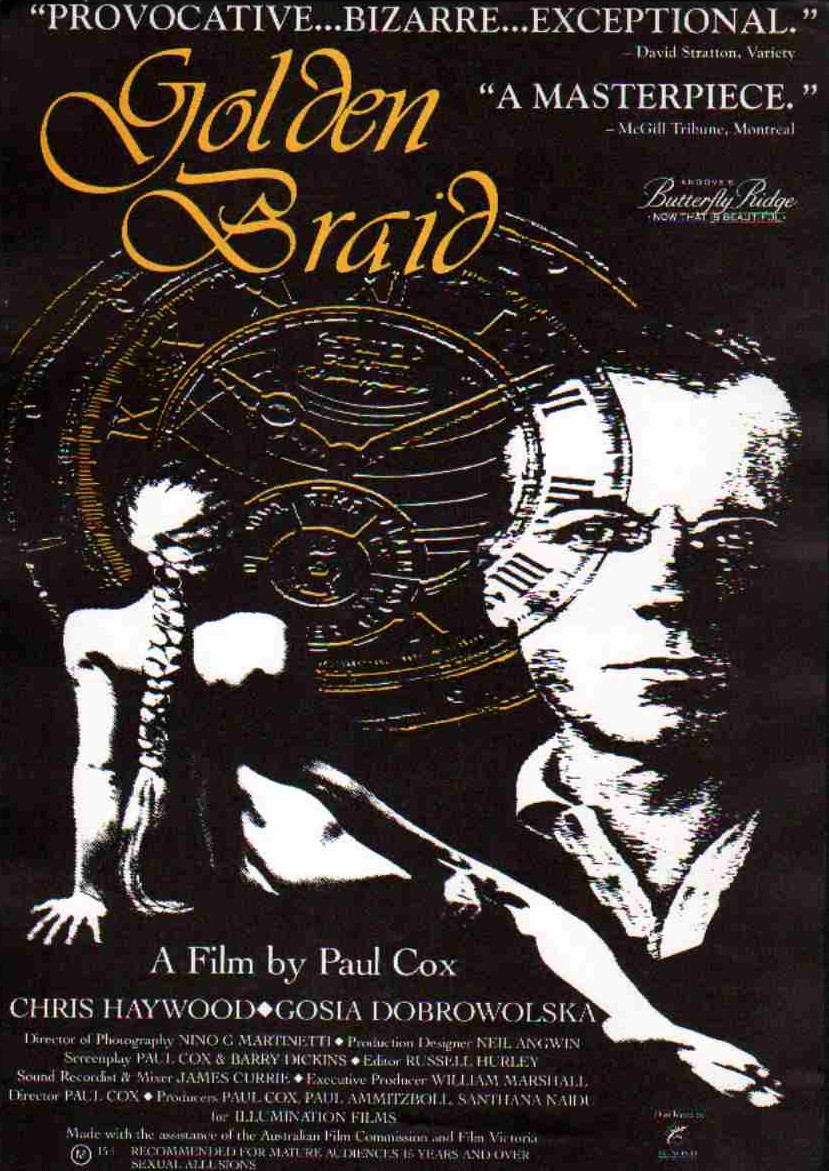
Australia’s Paul Cox is one of the most distinctive and eccentric filmmakers on the planet, and this is one of his strangest films. Based on a story by Guy De Maupassant, it’s about a love affair between a man and a woman, complicated by the fact that she’s married and he’s in love with a braid of blonde hair. Said braid, found in an antique dresser the guy is fixing up, obsesses this nutcase from the start, inspiring numerous bizarre hallucinations and causing irreparable damage to his relationships. Frankly I’m not exactly sure what-all happens in the end, which I found to be (like the rest of the film) gorgeously photographed, deeply felt and not a little pretentious.
26. WHITE ROOM
This was Canadian writer-director Patricia Rozema’s all-but forgotten follow-up to her impressive 1987 debut feature I’VE HEARD THE MERMAIDS SINGING. WHITE ROOM is a typical sophomore effort in many respects, with Rozema expanding on her first film in an oft-sprawling, self-indulgent mess. But it’s quite an intriguing mess, with Maurice Godin as a meek fellow who after witnessing the murder of a popular singer grows besotted with a mysterious woman (Kate Nelligan) he meets at the victim’s funeral. Turns out the woman was the dead singer’s voice, with the latter lip-synching songs that were pre-recorded in a secret room (a white one, of course) of Nelligan’s spacious mansion. The action is frequently intercut with surreal flights of fantasy, which constitute the film’s undoubted highlights—particularly memorable is the hero’s redemption through writing, an exhilarating sequence with fireworks literally dancing in his eyes and words leaping off the page and flowing through the air.
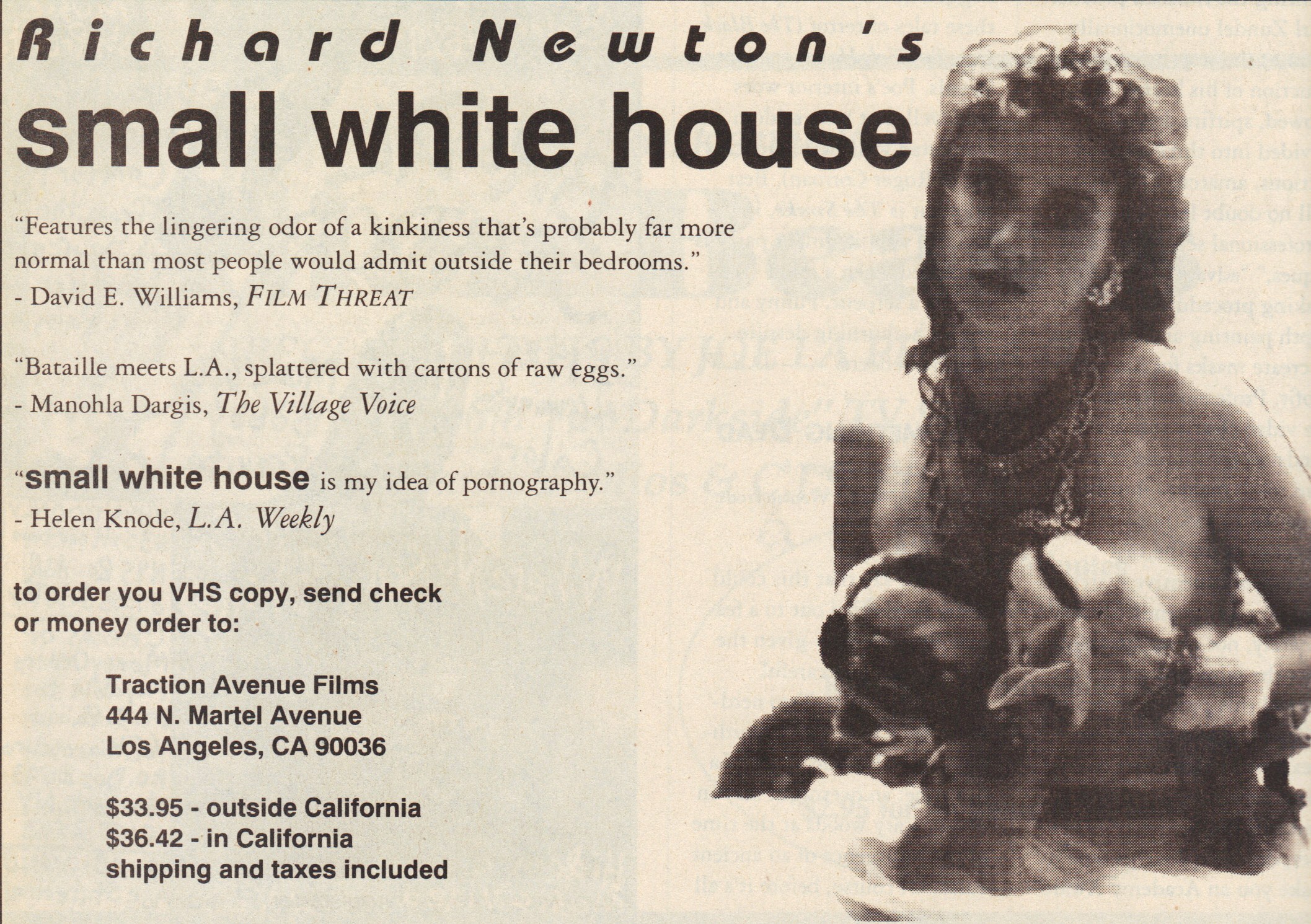 25. SMALL WHITE HOUSE
25. SMALL WHITE HOUSE
It may be pretty obscure nowadays, but this was one of the key underground films of the nineties, a beyond-strange Tijuana-set reverie on the JFK assassination. The setting is early-1960s Tijuana, where a hustler named Plato (Enrico Boetcher) lures a young couple named Jackie and Johnny, (Christina Kuta and Orb Kamm)—after JFK and his wife—into his fold. The sexually voracious Jackie and laid-back skateboarder Johnny have just arrived in Tijuana, and are up for all manner of experimentation, sexual and otherwise. Plato gladly indulges their whims, which come to include Johnny getting repeatedly shot in the head in the back seat of a car. Figuring this film out admittedly takes some doing, yet writer-director Richard Newton’s grasp of cinema is undeniable. The colorful imagery has a definite sense of style, and the artful cinematography by Sven Kirsten is a joy to watch. This doesn’t change the fact that the sexual angle is extremely blunt and off-putting (sample dialogue: “At least I know where her dildo’s been!”), and that Newton has an unnatural obsession with urination.
24. AFTER DARK, MY SWEET
One of the better entries in the 1990s Jim Thompson movie craze (which also included THIS WORLD THEN THE FIREWORS, HIT ME and the ‘94 GETAWAY), a tough, gritty little film that memorably captures both the quirkiness of Thomson’s world as well as its relentlessness. A never-better Jason Patrick plays an unstable escapee from a mental institution who falls into the orbit of two desert-dwelling criminals (Rachel Ward and Bruce Dern); in short order Patrick commences a romance with Ward and unwisely agrees to partake in a kidnapping scheme that of course goes horrifically wrong. As well done as all this is, director James Foley, as was his tendency, visualizes it in an overly glitzy manner, which is a constant distraction.
23. RA: THE PATH OF THE SUN GOD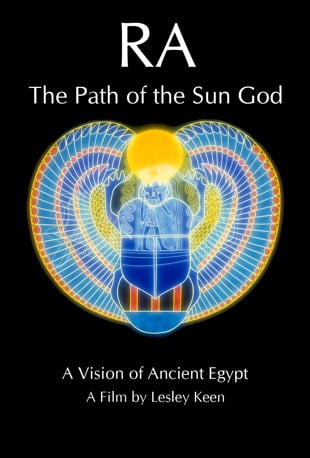
A true animated oddity, courtesy of writer-director-animator Lesley Keen, who spent a reported four years creating this spectacle. Utilizing an animation style at once primitive and innovative that harkens back to the pioneering silhouette cartoons of Lotte Reiniger yet with a very up-to-date hallucinatory thrust, it begins as, essentially, an animated lecture. Narration by Tamara Kennedy fills us in on the particulars of several Egyptian creation myths, dramatized by slipstreamy animation done up in the style of ancient Egyptian artwork. After about 25 minutes, though, the film becomes something else entirely, and a much richer and stranger something as the narration turns increasingly esoteric (“Oh Ra, let your rays descend, let your divine spirit fill the queen, let her consume”) and often cuts out entirely, with the increasingly psychedelic imagery left to speak for itself. All this will likely be incomprehensible to anyone without a working knowledge of Egyptian mythology, but it adds up to a deeply fascinating puzzlement without question.
22. DER TODESKING (THE DEATH KING)
Another sickie from Germany’s premiere nutcase Jorg Buttgereit (of NEKROMANTIC infamy). Here he crafts an episodic ramble about seven people who, over the course of seven days, each receive a chain letter that prompts a murder or suicide. The chain letter is really just a ruse, as Buttgereit’s true intentions are quite abstract and surreal. When the segments work they tend to work extremely well, as in one where a young woman straps on a camera and we view the resulting footage, showing her POV as she embarks on a random shooting spree at a punk rock concert. On the downside are a number of plain dull bits like the one featuring a loser banging his head against a wall for five minutes before (thankfully) expiring. If there’s a point to all this I missed it, but Buttgereit definitely succeeds in working up a uniquely deranged, downbeat tone that wormed its way under my skin.
 21. RASPAD (DECAY)
21. RASPAD (DECAY)
A Russian made account of the nuclear meltdown at Chernobyl that’s often quite powerful—notice I said often rather than fully. Director Mikhail Belikov offers very little info about what caused the meltdown or the efforts at containing it, instead focusing on the fear and chaos that enveloped the surrounding communities. In this Belikov succeeds in creating a genuinely alarming look at societal breakdown, with all-too-realistic scenes of hundreds of extras being herded into buses and clambering over one another in a crowded train station. There’s also a heartbreaking depiction of a young radiation-addled boy seen living alone in the abandoned ruins of Chernobyl, waiting in vain for his mother to return. The storytelling is somewhat incoherent, with the action switching haphazardly from one episode to the next without any connective tissue—or even, in many cases, a resolution, as in a climactic episode with scientists on a suicide mission in the contaminated area that just sort of…stops.
20. ARCHANGEL
Interesting: I’ve seen this, the second feature by Canada’s Guy Maddin, three times now, and have had a different reaction each time. I was utterly baffled after first viewing it (which marked my premiere exposure to Maddin’s work), while on second viewing I was impressed by how accurately it parodied Russian melodramas from the twenties and thirties. This time around I found myself reveling in Maddin’s unrelenting dream logic; ARCHANGEL is one of the few films to give ERASERHEAD a serious run for its money in the Pure Weirdness sweepstakes. Matter of fact, it may well be the absolute strangest of all Maddin’s films (no small claim!). Set during the Russian revolution, it features a Canadian soldier with amnesia who thinks he’s in love with a woman he’s never met. Lots of odd events occur in this scratchy black and white film, complete with deliberately stilted silent-movie acting and intentionally artificial sets: a bunker is assailed by an avalanche of white rabbits, a boy is attacked by twitching cartoon bugs, a soldier is strangled by his own intestine, etc. I’m not sure what ultimately happens, but was impressed by Maddin’s unwavering commitment to his own distinctively warped vision.
19. SVETO MESTO (A HOLY PLACE)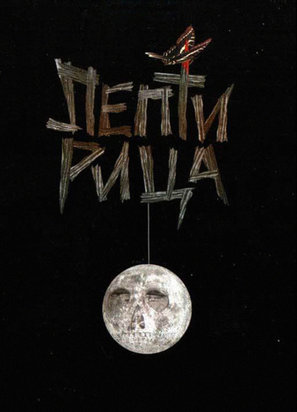
Serbian director Djordje Kadijevic’s SVETO MESTO appeared 17 years after his classic vampire drama LEPTIRICA, and it’s another shivery triumph. Based on Nikolai Gogol’s classic tale “Viy,” it can’t hope to complete with the former film, or even the previous ones based on the story—Mario Bava’s BLACK SUNDAY and the Russian VIY—but is an impressive work. As in the Gogol text and latter film it has an aspiring priest running into a ghost woman; he’s charged with looking after her corpse inside a church for three nights, an unexpectedly arduous task that scares the shit out of the poor guy and turns his hair white. Kadijevic adds much of his own to the narrative, including a perverse subplot involving the witch woman’s father, and also gives the gal more to do; when not terrorizing the protagonist in the church she’s out haunting the surrounding community in a variety of guises. There’s also the sexual angle, which is blunter here than in any previous version of this tale (including the original Gogol text).
18. THE MEDIATOR (POSREDNIK)
If Andrei Tarkovsky had directed INVASION OF THE BODY SNATCHERS it would probably have played like this singularly eerie and haunting sci fi reverie from Russia. THE MEDIATOR has the distinction of being the last fantasy film to be made before the collapse of the Soviet Union, a point many critics saw as being prescient to the film’s narrative, which happens to be about extraterrestrials methodically taking over a small town. Said aliens are first seen being transported within a ball of light contained in the back of a truck, from which they’re disgorged in a car accident. They spread their influence via a distinctly phallic weapon whose invisible rays turn people into mindless automatons—but as you might expect, a small band of humans manage to escape the aliens’ influence and fight back. The film has been called “STALKER for kids,” and while it’s not really appropriate as a children’s film it is very Tarkovsky-like, from the intensely dreamlike atmosphere to the somnambulant pacing, ultra-spare visuals (which switch from color to black-and-white with no seeming rhyme or reason) and characters who are always breaking into lengthy philosophical discussions about their predicament. If anything, director Vladimir Potapov has done his job a bit too well: the art direction, sound design and acting all seem quite otherworldly before the aliens take over, so there’s little sense of consequence once they do. Also, the 3½ hour(!) runtime is excessive, to say the least.
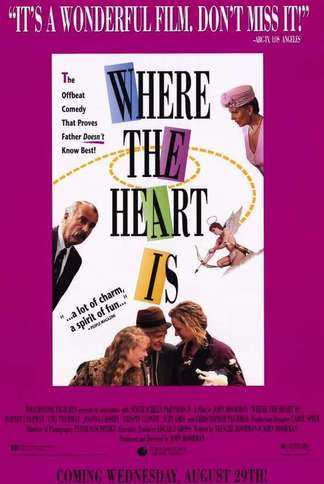 17. WHERE THE HEART IS
17. WHERE THE HEART IS
One of English filmmaker John Boorman’s biggest follies, although WHERE THE HEART IS isn’t really all that bad, being a visually striking and enjoyable bit of fluff. It’s essentially a Disney-fied remake of Boorman’s earlier folly LEO THE LAST, although this film reminded me more of THE FISHER KING, another early nineties Hollywood product by a maverick England-based director. Like THE FISHER KING’S Terry Gilliam, John Boorman was evidently at sea with the conventions of 1990s Hollywood, and just as evidently tried his damndest to make the best of a bad situation. The script by Boorman and his late daughter Telsche posits that a fed-up NYC demolitionist (Dabney Coleman) sends his college-aged children (Suzy Amis and Uma Thurman among them) to live by themselves in a Brooklyn townhouse, which of course they turn into an artistic wonderland with the help of a bunch of eccentric tenants (played by Christopher Plummer and Crispin Glover, among others). Eventually, though, Coleman and his wife (Joanna Cassidy) wind up moving in with the kids after the stock market crashes, and somehow it all ends happily.
16. MEMPHIS BELLE
A shallow, shamelessly commercial WWII flick, but a satisfying piece of work nonetheless. If you can get through the dull opening 40 minutes you’ll find an entertaining and (I’m told) reasonably authentic depiction of aerial combat in the skies of Europe circa 1943 (albeit one with some pretty rotten pre-CGI model work). The protagonists are the youthful crew of the “Memphis Belle” bomber plane on its final run. During that time the plane sustains a lot of gunshots, the loss of an engine, a jammed landing gear and many other disasters, yet the crew—whose ranks include Matthew Modine, Eric Stoltz, D.B. Sweeney, Sean Astin, Harry Connick Jr. and many other notables—all survive the trip. I couldn’t help but get drawn into it.
15. ROSENCRANTZ AND GUILDENSTERN ARE DEAD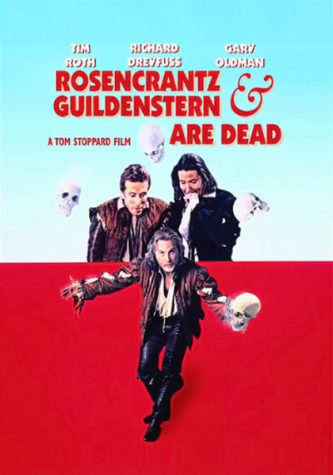
This brainy comedy was the directorial debut of playwright Tom Stoppard, adapting his award winning stage piece. Tim Roth and Gary Oldman play Rosencrantz and Guildenstern, two minor characters from the Bard’s HAMLET who find themselves trapped in a barren never-never land. They’re periodically transposed to the castle where the play is set and made to be participants in the story, until the end, when one of the characters mouths Shakespeare’s immortal words “Rosencrantz and Guildenstern are dead”…and they follow suit. There’s far more to it, of course, most notably Richard Dreyfuss as a smart-assed actor/magician with a far greater understanding of the nature of Rosencrantz and Guildenstern’s world than they themselves possess. As a piece of drama the film is at once a sly critique of Shakespeare’s work (and two of its more underwritten characters), a Kafkaesque exploration of modern man’s existential dilemma and an oft-perplexing probe of the ever-shifting boundary between fantasy and reality. Stoppard has done a good job translating his stage-bound material to the cinema, although it does naturally get a bit overly talky at times.
14. CLASS OF 1999
An ersatz sequel by producer/director Mark Lester to his teensploitation classic CLASS OF 1984, and a damned enjoyable film. Co-written (uncredited) by the famed splatterpunk scribe John Skipp, it’s a deliriously violent sci fi blow-out in which android teachers on a killing rampage replace the homicidal students of the earlier film as objects of terror. It seems these teachers were designed as objects of war by the US military, which explains their penchant for cold-blooded brutality. The students, though, led by a just-paroled gangbanger (Bradley Gregg), decide to fight back, leading to an intense, explosion-packed climax. This is fun stuff, with expert pacing and cannily staged mayhem. It’s also great to see Pam Grier as one of the teacher-androids, Stacey Keach as her asshole boss and Malcolm McDowell as the kind-hearted but none-too-bright school principal.
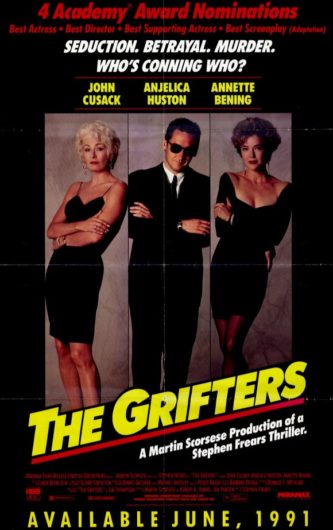 13. THE GRIFTERS
13. THE GRIFTERS
This was the foremost entry in the 1990s Jim Thompson movie craze, and no wonder, as it was the product of no less than three world class talents: producer Martin Scorsese, screenwriter Donald E. Westlake and director Stephen Frears. What they’ve come up with is a dark humored and uncompromising adaptation of Thompson’s scathing 1963 novel. It involves a trio of small-time con artists who include John Cusak as a young punk who likes to fleece bar owners, Angelica Huston as his even-more amoral mob-connected mother and Annette Bening as his sexpot GF. All are superbly played, with Huston, who seems an odd casting choice (she’s a lot older, for starters, than her character was supposed to be), emerging as the standout. The exploits of these three no-hopers, involving violence and disillusionment of a type that could only emerge from the mind of Jim Thompson, are extremely well executed with a spot-on eye for grit and gore (in this film’s pitiless universe, as in Thompson’s fiction, women are dealt with just as harshly as men). Admittedly, Westlake and Frears never quite succeed in properly updating the material from its early 1960s origins, when “playing the twenties” and fixing horse races seemed a lot more feasible than they did in 1990, but the film still works smashingly well.
12. INFINITY
Self-proclaimed “one of the most important films ever produced,” this is an ineptly made, zero-budgeted yet quite sincere dose of unadulterated new age hooey—and a longtime bad movie favorite of mine. It involves a retired naval officer, his wife and their bimbo daughter discovering a tropical island inhabited by a mad scientist and his young protégée Daniel, who’s being groomed to be the next Jesus…or Buddha…or something. So far it looks like the scientist is doing pretty well, as Daniel can read minds, heal wounds and if you put your hand on his forehead you can mentally travel through the ocean (although if he’s in an extremely good mood all you’ll see is a bright light). While the adults stay ashore discussing the nature of Christ and the true meaning of miracles Daniel and the young woman frolic in the sea; unfortunately, at about this point a storm hits and their boat is ravaged by what has to be the hoariest looking fish tank wave I’ve ever seen. The youngsters are killed but meet again on another plain of existence, while the scientist intones the final, none-too-haunting refrain “Daniel is fine…Daniel will always be fine!”
11. VINCENT AND THEO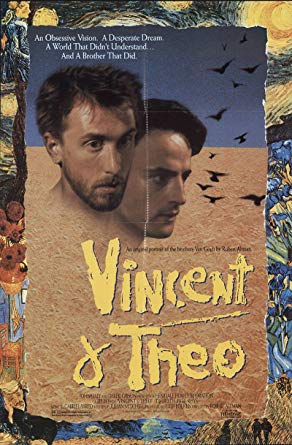
The late Robert Altman’s dark, sinister and altogether fascinating take on LUST FOR LIFE features Tim Roth as Vincent Van Gogh and Paul Rhys as his brother Theo. The argument espoused by Altman and screenwriter Julian Mitchell is that these two were dependent on each other for sustenance, with Vincent an irresponsible loafer who nonetheless gave his art dealer brother a credibility he wouldn’t otherwise have possessed. Altman visualizes this tragic saga in suitably painterly fashion through impeccably composed visuals and prowling camerawork, intercutting the exploits of Vincent and Theo in notably elliptical and impressionistic fashion. In this way we’re made aware of how Vincent’s encroaching madness affected not just his own life but Theo’s as well, until the latter wound up as crazy as his brother. No, this isn’t a pleasant film, but it is a unique and invigorating one that bears Altman’s unmistakable stamp throughout.
10. BABY BLOOD
One of the decade’s most memorable genre excursions in my view, a funny, scary, gruesome and deeply perverse horror spectacle. The story concerns a woman (Emmanuelle Escourrou) impregnated by a slimy eel-like critter. As the fetus grows in her stomach it actually talks to her, revealing the little guy needs blood to survive. Thus the kid leads Ma on a killing spree, and does evil things to her insides when she doesn’t comply with its wishes. That’s a pretty incredible concept, and writer/director Alain Robak does it justice in a fast moving, incident packed 85 minutes. Much blood is spilled and the woman eventually gives birth to what looks like a normal baby…until it sheds its human skin to reveal itself as a face sucking what’s-it that proceeds to terrorize a crowded bus. It’s that kind of movie.
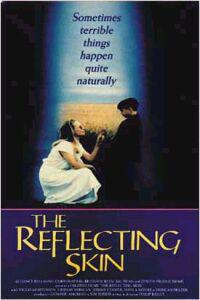 9. THE REFLECTING SKIN
9. THE REFLECTING SKIN
One of the best of the David Lynch wannabes from the late 80’s-early 90’s. Eschewing the jokey, self-satisfied tone of THE DARK BACKWARD and ROADSIDE PROPHETS (two lesser examples of the trend), writer-director Philip Ridley presents a fully realized vision grounded in a very real sense of disillusionment and despair. Seth (Jeremy Cooper) is a 10-year-old brat who lives in a godforsaken prairie town sometime in the early 1940s. His older brother (Viggo Mortensen) is off fighting in the Pacific, his mom (Sheila Moore) is an abusive nut and his dad (Duncan Fraser) is a pedophile. That’s in addition to the old lady neighbor (Lindsay Duncan) who may be a vampire and the leather jacket-wearing gang who seem intent on killing off Seth’s friends. It’s all quite compelling, with stunning photography and a steadily building ambiance of impending doom. Once Mortensen arrives home things really hit the fan, with multiple deaths, a conflagration and the finding of a friendly fetus (don’t ask), leading to a heartbreaking final scene. In case you haven’t figured it out yet, this is NOT the feel good movie of the year, but it is strong, uncompromising and, ultimately, brilliant.
8. TRUST
This fully assured and defiantly individual piece of filmmaking may well be Hal Hartley’s finest film. The deadpan tone, rigorously composed visuals, minimalist score, highly stylized performances and precisely measured dialogue attest to a cinematic sensibility as distinctive as that of nearly any filmmaker I can think of. The late Adrienne Shelley plays a teenage miscreant whose father unexpectedly drops dead after she smacks him and runs off. Martin Donovan plays a much older man living with his abusive father who finds kinship (read: romance) of a sort with Shelley, who in turn embarks on a haphazard self-improvement campaign. Hartley deals impactingly, and of course quirkily, with issues of trust, empathy and the true nature of love. It doesn’t end as you might expect, as Hartley’s vision (to its credit) is far thornier and more complex than it might initially seem.
7. SINGAPORE SLING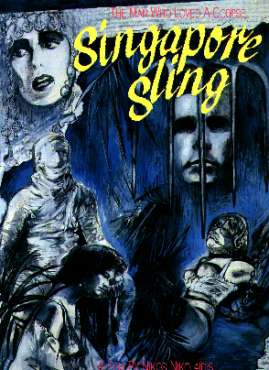
As potent a piece of cult movie dementia as any I’ve seen, a profoundly deranged Greek import that also happens to be beautifully made and impossible to ignore. It’s extremely noirish in its ultra-shadowy black-and-white photography, often feeling like writer-director Nikos Nikolaidis took any number of 1940’s-era noir movie clichés and mixed them into a decidedly up-to-date swirl of perversion. It’s about a detective (Panos Thanassoulis) who, searching for his lost love, stumbles onto a mansion owned by a crazy woman (Michele Valley) and her equally nutty grown daughter (Meredyth Herold), who spend their days playing sexually-tinged role-playing games and murdering anyone who comes near ‘em, while keeping the mummified corpse of their depraved patriarch nearby! They quickly induct the detective, who they christen Singapore Sling after the cocktail recipe found in one of his pockets, into their twisted universe, tying him up, puking on him, hooking him up to a homemade electroshock machine, etc. Inevitably the detective comes to take a more active role in these games, and the film moves inexorably toward a wildly psychotic conclusion that’ll have mainstream viewers climbing the walls. The actors are extremely game in this shimmering fever dream of a movie, which takes artsploitation to new heights (or lows?).
6. MINDWALK
A most invigorating experiment that attempts, a la MY DINNER WITH ANDRE, to make a conversation the centerpiece of a feature film. For the most part it works, with a politician (Sam Waterston), a poet (John Heard) and a scientist (Liv Ullman) meeting at a scenic abbey in France’s Mont St. Michel and getting into an epic day-long discussion that covers Descartes, atomic physics, nuclear power, political culpability and global warming. Such lofty concepts are largely off-limits in modern moviemaking, which is part of what makes MINDWALK so vital. There are some missteps, most notably the frequent intercessions of Ione Skye as Ullmann’s flighty daughter (on hand to show that despite her lofty thoughts and aspirations Ullmann still has a lot to learn about human interaction). But the film also contains breathtaking scenery, mind-tugging concepts and an excellent Philip Glass score, which nearly make up for the fumbles.
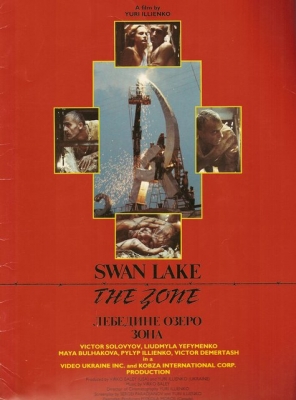 5. SWAN LAKE: THE ZONE (LEBEDYNE OZERO. ZONA)
5. SWAN LAKE: THE ZONE (LEBEDYNE OZERO. ZONA)
Former Sergei Paradjanov cohort Yuri Ilyenkno crafted this astonishing film from (heavily fictionalized) stories told by Paradjanov about his years in prison. Of course the film, set during the Soviet Union’s calamitous final days, is much closer to Tarkovsky than Paradjanov in its starkly poetic atmosphere. Taking place in a bleak and ugly industrial landscape that’s apparently adjacent to the Zone of Tarkovsky’s STALKER, it has a nameless man (Viktor Solovyov) on the run holing up in a hollow hammer-and-sickle monument (the first example of the film’s sledgehammer symbolism, and by no means the last). He’s visited by a mischievous boy and his love-starved mother (played by Ilyenko’s actual wife and son). Eventually the man is captured by authorities and taken back to the prison he apparently escaped from…but not until after he’s been brought back from the dead by a blood transfusion (complete with Biblical voice-overs—more none-too-subtle symbolism). In the end the guy commits suicide by slashing his wrists with a broken light bulb as his lover eagerly waits by the monument. There’s very little dialogue in this hallucinatory film, which relies on Ilyneko’s hypnotic visual sense (as usual, he acted as his own cinematographer), not to mention a strikingly textured soundtrack.
4. BULLET IN THE HEAD (DIE XUE JIE TOU)
It’s a popular subject of debate among film nerds whether THE KILLER (1989) or HARD-BOILED (1992) represent the best that Hong Kong’s John Woo has to offer; as for myself, my choice is BULLET IN THE HEAD, which fell between the former films chronologically. There has certainly never been a more outrageous action movie spectacle made in Hong Kong or anywhere else, as in this film more than any other Woo really pushes his passions for mass killing and male bonding to their breaking points. The admittedly clichéd premise involves three friends forced to flee their native Hong Kong in the late 1960’s after they kill a local hood. Arriving in Vietnam, they discover a society more lawless and corrupt than the one they just left, and before the film is over the guys will have spent time in a prison camp and forced to shoot several fellow detainees (undoubtedly one of the most profoundly unpleasant sequences of all time), after which one of three turns corrupt, another goes crazy from a bullet stuck in his head(!) and the third is tasked with finishing things off. The climax is one of the damndest things I’ve ever seen: a full-on jousting session with cars instead of horses amidst a veritable torrent of blood and fire.
3. SPLIT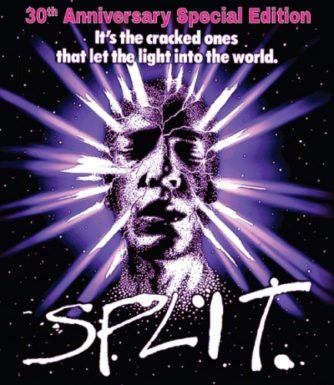
Here’s a little-known science fiction no-budgeter, a real mindbender in line with THEY LIVE and THE MATRIX, but with a style and attitude all its own. It’s the wildly psychedelic account of Starker (Timothy Dwight), a seemingly schizophrenic street punk who’s discovered that our every action is closely monitored and controlled by a band of extraterrestrial humanoids who follow the dictates of a megalomaniacal basket case (played by the film’s director Chris Shaw); naturally Shaw and his subordinates are looking to hunt down and silence Starker for good, but he always manages to elude them. The film is graced with startlingly odd camera set-ups and elaborate computer effects that seem a tad primitive these days but, taken within the context of the story, still manage to startle. And let’s not forget the film’s innovative use of sound, which includes many old fashioned whizzing and buzzing noises that are, again, a tad out of date nowadays, but, again, work well in creating an atmosphere of ever-present futuristic paranoia. This is one of the trippiest films you’ll ever see, with a continually mutating narrative and at least one honest-to-goodness onscreen acid trip. It’s held together by writer/director/designer Chris Shaw’s undeniable filmmaking savvy and conviction. I’ve never seen anything quite like SPLIT, and would LOVE to see Shaw make another (although, considering it’s been nearly thirty years, I’m not exactly holding my breath).
2. BEGOTTEN
A beautiful, grotesque, near-otherworldly mutant of a movie. Wordless and barely linear, BEGOTTEN is an ultra-grainy black and white ramble that begins with God (so identified in the end credits) disemboweling Himself and birthing Mother Earth, an eye mask wearing freak who uses God’s sperm to impregnate herself with a twitching, immobile offspring who spends the remainder of the film being dragged around and getting his ass kicked by cavemen. Other goodies include a gang rape, at least one additional dismemberment, and an abundance of strange, upsetting yet curiously elemental imagery from which I had a difficult time tearing my eyes.
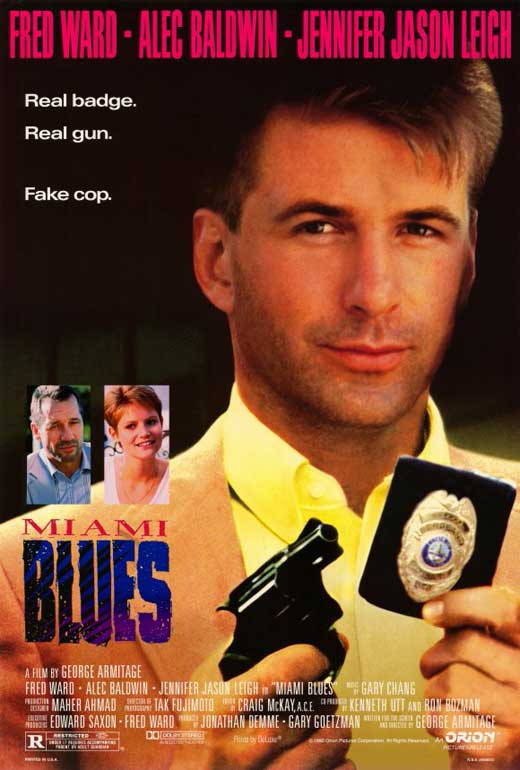 1. MIAMI BLUES
1. MIAMI BLUES
Quite simply one of the great underrated American films of the past three decades. It’s crime-themed dramedy that were it made today would doubtless by called Tarantino-esque. In fact it was adapted, quite faithfully, from a novel by the great Charles Willeford (an admitted influence on Tarantino), whose inscrutable genius is in full evidence in this film, which was stylishly and energetically directed by George Armitage (of VIGILANTE FORCE and GROSSE POINT BLANK). He gives the proceedings a real sense of menace, mixed with pitch black comedy, in what was easily the best such effort since Jonathan Demme’s similarly underrated SOMETHING WILD (no surprise: Demme co-produced the present film). Alec Baldwin has never been better than he is here, playing the charismatic but hopelessly sociopathic Junior Frenger; ditto Jennifer Jason Leigh, who all-but steals the show as Frenger’s airheaded hooker girlfriend, and Fred Ward as Sergeant Hoke Mosely, the gruff detective whose constantly disappearing false teeth make for a great running gag. There are also fun appearances by Charles Durning as Hoke’s former partner and Nora Dunn as his present one, Paul Gleason as a shifty cop and THE HONEYMOON KILLERS’S always-watchable Shirley Stoler as a doomed pawn shop proprietor. Then there’s Armitage’s full-bodied, atmospheric portrayal of Miami, a dangerous yet curiously inviting beachfront environ.
